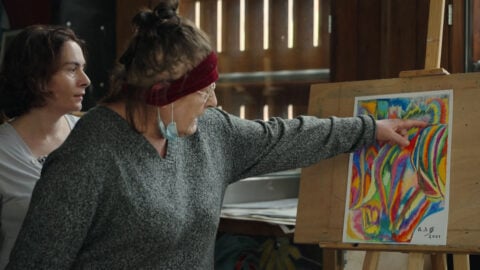The Film Comment Podcast: New Red Order
A couple weeks ago, I visited the Artists Space gallery in downtown Manhattan to check out the ongoing exhibit, “Feel at Home Here,” by New Red Order—a “public secret society” with rotating members who create exhibitions, videos, and performances that question and re-channel our relationships to indigeneity. As I walked into the gallery, the lobby welcomed me with an assortment of marketing paraphernalia: a poster advertised “Savage Philosophy™”; a red landline invited me to call a hotline; and a screen played a video of a white man exhorting me to “never settle” and to realize my “fullest potential” by joining his organization, the New Red Order.
Was this the merchandise section of the gallery? A marketing or recruitment video? Or a parody? I couldn’t quite tell at first.
This slippage between satire and fact, which constantly reminds us of the all-too-real absurdity of the settler colonial project, is the modus operandi of New Red Order. As I walked further into the exhibit, one wall featured a sardonic timeline of the history of the Improved Order of Red Men, a whites-only political society that New Red Order riffs on subversively. One section of the room was modeled as a real-estate office for “Giving Back™” land. And the centerpiece featured a rotating video installation, which included New Red Order’s feature-film-slash-recruitment-campaign, Never Settle.
To dig into the exhibit’s provocative plays with time, futurity, guilt, ownership, and desire, I spoke to New Red Order’s “core contributors,” as they describe themselves: Jackson Polys, Adam Khalil, and Zack Khalil. This week’s podcast presents a short excerpt of our conversation, and you can read an expanded transcript below.
You describe New Red Order as a “public secret society.” What does “public secret” mean to you?
Adam Khalil: The big thing about our public secret society is anyone can join. So, shameless plug, if you wanna sign up, it’s newredorder.org, or you can call our hotline at 1-888-NewRed1.
NRO actually emerged from a real secret society, The Improved Order of the Red Men and the Degree of Pocahontas, which goes back to the Boston Tea Party. When the British colonists protested the tea tax of the Boston Tea Party, they all dressed up as Mohawk or Haudenosaunee native people. That spawned the Improved Order of the Red Men, which also has connections to Tammany Hall and the Sons of Liberty, and is foundational to the start of the settler-colonial project of America. Its members included Teddy Roosevelt, FDR, Nixon, and other leaders in business and politics. They would meet up in wigwams and dress up in native regalia. They still exist; they’re headquartered in Waco, Texas. New Red Order is in counter-distinction to The Improved Order of the Red Men and The Degree of Pocahontas; a kind of outgrowth.
The idea for the public secret comes from Mick Taussig, who’s an anthropologist at Columbia. He writes a lot about public secrets, which are things we all know to be true but don’t ever discuss. And one of the ultimate public secrets being the ongoing settler-colonialism that’s happening in Turtle Island in North America. Part of the hope is that when people sign up to join our public secret society, we kind of reveal that secret and unpack it together.
Jackson Polys: One of the facets of that public secret is settler-colonialism, which includes legacies of, and is in some ways dependent on, playing Indian or wanting to become Indian as one of the ways of learning how to feel at home here. That is enacted through various forms, some of which may be seen as inappropriate desires toward indigeneity. New Red Order allows for an interrogation of that kind of activity and that kind of desire.
Zack Khalil: For us, labeling ourselves a public secret society is really important as opposed to something more limiting, such as an art collective. New Red Order is something continuing to expand and grow in different ways as we continue to recruit more and more members. It exists in a certain liminal space between an activist organization, a political party, a cult, and an actual secret society, to not limit the potential of where the organization could go or be.
With New Red Order, there seems to be a deliberate refusal of an origin story or the impulse to ascribe a particular moment to the group’s founding. What motivates this nebulous, ever-mutating formation?
JP: I think there is a refusal of the desire to encapsulate origin stories and mark definitive points for when things started. Part of that is a resistance to an idea [central to] settler colonialism and nationhood, which is that the nation-state was founded at a particular moment, when we know it’s been a process of reinstatement. That’s an undercurrent of what might be called our refusal of an origin story. Also, this relates to the desire to conflate natives with nature and to pinpoint their origin stories as starting some point prior to history, which can then never be marked but is also negated because it’s not seen as an actual historical moment or even time period. We’re toying and playing with these layers of conflation that result in the primitivism that continues through today.
Given that you prefer to be undefined so as to not limit your potential, what guides your choice of mode, be it video art or installation? Why does this exhibition take the shape that it does?
AK: To both clarify and muddy things a bit, a lot of our work starts at a certain point but stays ongoing. It’s never really complete. We’re invested in working iteratively, so as not to foreclose possibilities. There’s a larger film embedded within the installation, called Never Settle, which we started in 2018 but haven’t finished yet. Each exhibition is an opportunity to keep adding to it. That’s been a rewarding way to work, because we’re able to be nimble and respond to what’s happening in the world. But we’re hoping to round it out and finish it as a feature “documentary” in the next year or so.
ZK: There’s a part of the show that takes the form of a real-estate office, and features over 25 examples of settlers who’ve voluntarily repatriated land to indigenous communities in the United States and Canada. This non-metaphorical decolonization is a big part of our project. This idea that decolonization isn’t just a word comes from the amazing essay, “Decolonization Is Not a Metaphor,” by Eve Tuck and K.W. Yang. The thesis is that decolonization in the settler-colonial context of the United States asks that we repatriate indigenous land. The real-estate office allows us to show that that is possible, and in fact already happening. People often forget that it took almost 500 years for the land to be colonized, to be taken away piece by piece. It didn’t all happen at one time. So it may take 500 years to return it step by step, piece by piece, individual by individual.
The way that you depict NRO in your videos seems to cleverly parody the whites-only membership of the Improved Order of the Red Men. As far as I could tell, all the people in Never Settle, whom you call informants or accomplices, are non-native, and the spokesperson is a white actor named Jim Fletcher.
AK: That’s a juicy point that we’re very invested in. A strange outcome of identity-based art is that indigenous artists have to perform their indigeneity every time they exhibit something. There’s a clear desire from institutions and the arts-going public to see that performance. We’re trying to undermine and refuse that. So, yes, in Never Settle, there isn’t a single indigenous person, but it’s all about indigeneity. Part of that is also that numbers-wise, native people are less than 1 percent of the population, so to effect any actual change we would need to develop coalitions that exist outside of self-organizing.
If you think about something like Standing Rock, the message was “water is life,” but the real message was “respect indigenous sovereignty.” But that’s too complicated and unsettling of a notion to make into a slogan, so it had to be dumbed down, so that other people could get behind it. We’re trying to move away from centering whiteness and equating that with settler colonialism, but then also have avenues of coalition-building that acknowledge all of our complicated backgrounds. Even myself, I’m part white and part Egyptian, and I’m not trying to deny those things but really engaging in that mess and trying to make some sense of it.
ZK: The decision to not present ourselves or other indigenous people in our work is very intentional, and comes from the realization that as indigenous artists we’re asked to be informants on our own communities, in the typical anthropological sense. We’re interested in actively refusing that, and asking non-indigenous people to act as informants on their own communities and their own desire for indigeneity.
Much of the conversation around decolonization ends up focusing on the guilt of the settler. The informants in Never Settle say things like “I’ve learned how to help without getting in the way.” There’s also a moment where Fletcher says, “Do you feel BAD? I feel BAD.” You’re making fun of the fixation on settler-guilt, but you’re also getting at how inescapable those emotions are. I mean, how do we think through this stuff collectively without some element of shame?
JP: We’re starting to talk about ways in which by using a proxy and centering different aspects of whiteness, we’re focusing on indigeneity through an Other’s lens. Not the classically, typically Other, but another Other.
A reverse Other. [laughs]
JP: Yeah, reverse Other. [laughs] There’s a tension between doing that and occluding or minimizing actual indigenous voices. But as we mentioned earlier, we’re trying to get away from the dynamic of people having to put in the labor of reproducing their own indigeneity. We recognize that this can get ridiculous in terms of trying to avoid all the red flags, but that perhaps is one of the ways of moving through guilt and shame and acknowledging the ludicrous contortions that can result when one tries to apologize.
ZK: I think guilt and shame and victimhood are motivating factors, but they’re problematic starting points for an authentic, meaningful relationship. Guilt is actually more self-interested than it might seem on the outside. One of the lines that Jim Fletcher came up with that has stuck with me, because it’s so true, is that “It’s not about me, but for me, it is.” I think there’s a reality in that.
The thing I was butting up against while thinking through these ideas is that victimhood often seems to be the only means through which marginalized communities can articulate any political agency. It’s a double-edged sword. They have to define themselves as victims or risk not getting heard at all.
AK: The performance of indigeneity is performed by indigenous people as well. We’re also on the hook for it. We’re trying to figure out ways to short-circuit that or glitch that out, but it’s also slippery. There’s the stuff that just happened at the residential schools in Canada, with [the discovery of] all the mass graves. The guilt and shame of that nation, and what its people are feeling with regard to that history, is real and profound and deserved. One of the things we’re constantly playing with is the assertion that decolonization is not a metaphor, but also the idea of “savage philosophy” from Christopher Bracken. One is calling for material and political change, and the other is saying that metaphors and symbols can have material consequences, too. Conflating those two opposing ideas is how we’re trying to navigate that sticky terrain. That’s also the reason New Red Order is not just us. It’s a revolving door of people who participate in different ways, and keep each other in check in terms of whether we’re getting too metaphorical and not concrete enough or vice versa.
What you’re saying about both the power of metaphors and the ways in which they’re inadequate comes through in the section of the show that has to do with monuments. You have a two-channel piece, Culture Capture: Crimes Against Reality, that shows statues being sort of blown apart and reconstructed, and there’s a striking quote about how statues exact revenge on reality. Can you talk a little bit about that part of the work?
AK: We’re trying to get away from “de-” and “re-” language, and instead formulate new approaches that aren’t centered on undermining something that existed before. In 2017 or 2018, there was a New York City government-run committee about what to do with problematic statues and monuments. One of these was the Teddy Roosevelt monument in front of the American Museum of Natural History. The conclusion after a lot of hemming and hawing was that an additive approach needed to be pursued, and in this context, that meant adding a plaque to give context as to why the statue was problematic. We thought this additive approach was actually quite interesting, and had to do with making something new as opposed to tearing something down. There’s a double-edged sword with indigeneity and erasure. Representation of Indian people is ubiquitous but it’s also going away. Like with the Land O’ Lakes butter. There was this Indian woman on her knees in front of the lakes, and they got rid of her, and now it’s just the lakes. And it’s like… wait a second. That brings up these weird parallels with what’s actually happening. [laughs] So, yeah, the idea behind using a photogrammetric technique [in Culture Capture: Crimes Against Reality] was to take an additive approach to these types of complicated monuments. It’s this kind of cumulative gesture that could maybe lead to more interesting futures than erasing and hiding [things].
The interview has been edited and condensed for clarity.
Links & Things:
“New Red Order: Feel at Home Here” at Artists Space, showing until August 21
Become an Informant for New Red Order at newredorder.com
Defacement: Public Secrecy and the Labor of the Negative by Michael Taussig
“Decolonization Is Not a Metaphor” by Eve Tuck & K. Wayne Yang
Magical Criticism: The Recourse of Savage Philosophy by Christopher Bracken











